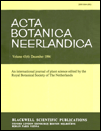Plasma membrane H+-ATPase activity in salt-tolerant and salt-sensitive lines of spring wheat (Triticum aestivum L.)
SUMMARY
Relationships between the primary H+-ATPases on the plasma membrane (PM-ATPase; EC 3.6.1.3) and vacuolar membrane (V-ATPase; EC 3.6.1.3) and the degree of salt tolerance were determined in spring wheat (Triticum aestivum L.), using fresh and dry weights and PM-ATPase and V-ATPase activities in shoots and roots from plants differing in salt tolerance. The salt-tolerant line, ‘Selection line’ (developed after mass screening of F3 variable seed material from a cross of two salt-tolerant wheat cvs, LU26S and Kharchia) and the relatively salt-sensitive variety, ‘Yecora Rojo’, were subjected for 8 days to aerated solution culture containing 0 or 100 mmol/L NaCI in full strength Hoagland's nutrient solution after an initial growth of 22 days in normal non-saline conditions. The salt-tolerant line was superior to the salt-sensitive line in terms of shoot biomass production under saline conditions. The former line accumulated less Na+ in both shoots and roots and maintained high K/Na ratio in the shoot compared to the latter, although the lines did not differ in root K/Na ratios. Selection line showed about 17% more activity of shoot PM-ATPase in the salt treatment compared to control, whereas a considerable decrease (about 45%) in shoot PM-ATPase activity due to salt was observed in Yecora Rojo. In contrast, in roots, an increase in PM-ATPase activity was observed in Yecora Rojo under saline substrate, whereas no influence of salt was observed on root PM-ATPase activity in Selection line. V-ATPase activities in shoots and roots were not significantly different among lines and were not affected by the salt treatment. From this study it appears that PM-ATPase activity in the shoot of tolerant plants was stimulated by salt, but PM-ATPase activity in the root was not. Both these conditions are postulated to be important components of salt tolerance in spring wheat.




